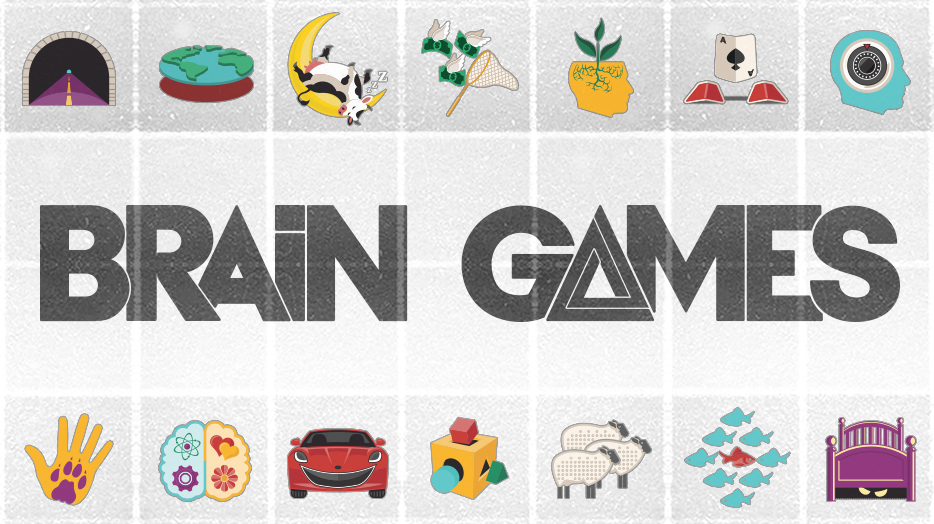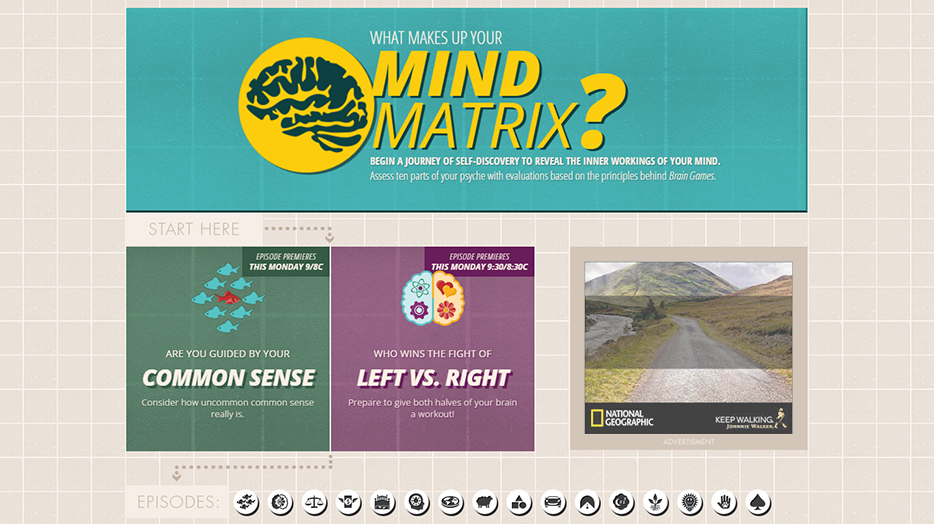








An all-new array of Brain Games quickly unravels the mysteries of the enigmatic Mind Matrix, revealing formative secrets unbeknownst to even the most self-aware psychonauts.
The human mind is a beautiful, complex machine that still harbors untold mysteries for even the most dedicated brain scientists. For the fourth season of National Geographic Channel’s Brain Games series, we gave brainy fun-seekers the tools to reveal the secret of their Mind Matrix by measuring the strength of different facets of their mind. A total of 80 unique, challenging assessments including puzzles, optical illusions, ethical quandaries, and more provided an ever-changing view of the mind of the participant.
The more Brain Games activities a user completed, the more accurate the Mind Matrix result could become. As each episode assessed the mental machinations of participants, those who logged in using Facebook were compared to their friends, revealing strengths, weaknesses, and compatibilities. Are you super detail-oriented, but not terribly creative? You and a disorganized-but-imaginative friend might be able to help each other. Book-smart and practical? Work with a street-smart dreamer for the perfect pairing!
Project Services
Making the Mind Matrix
While photographs and multiple-choice questions dominated previous seasons of Brain Games interactives, we pulled out all the stops for the season four redesign. With an all-new look and more assessment types than ever before, there was plenty of fresh, brain-bending fun for everyone.
-

New mechanics
Although some assessments still relied on multiple choice selections, we added drag-and-drop sorting and slider inputs to spice things up a little. New play mechanics gave us more creative freedom and offered more variety for Brain Games fans.
-

Let it slide
Moving the slider on certain questions controlled simple animations to reflect the user's answer. In this example, the view out the window appears to progress from day to night as the slider moves to a later hour.
-

Visual flexibility
We decided to focus on illustrations for season four, but we were perfectly content to use photographs when they were appropriate for an assessment. In this scene, we asked users to find as many hidden faces as possible.
-

Buy it or shoot it
While many projects make use of purchased stock photography (including this one), sometimes the perfect image isn't for sale. In these cases, we bust out the camera and create exactly what we need. Can you tell which bills are real and which are fake in this photo? Take the Perspective assessments for the answer!
Rebuilding Brain Games
Since we were already busting our brains re-engineering the core mechanics to accommodate the new Mind Matrix, we seized the opportunity to give the experience an entirely new look.
Clean, colorful illustrations and quirky animations replaced the largely photo-driven visuals of previous seasons, and the change made everything feel more playful without detracting from the brain science. As before, all assessments gave viewers the chance to experience Brain Games concepts with fun, shareable activities. We made it a priority to create new assessment mechanics, so activities could include dragging and sorting or manipulating sliders in addition to the tried-and-true multiple-choice questions that ruled previous seasons. To keep things mobile-friendly, assessments were bite-sized and easily consumable in short sessions, but each topic also offered Internet-exclusive articles and videos that helped Brain Games fans expand their minds even further.
Press Awards & More
-
2016 Communicator Awards: Silver
-
2015 W3 Awards: Gold
-
2015 W3 Awards: Silver
-
The FWA Public Shortlist
- Total Award Items: 4
- Total News Items: 0
- Total Items Combined: 4












